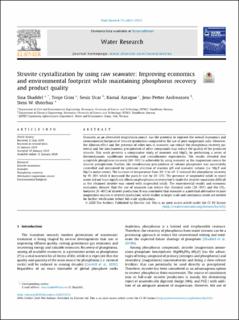| dc.contributor.author | Shaddel, Sina | |
| dc.contributor.author | Grini, Tonje | |
| dc.contributor.author | Ucar, Seniz | |
| dc.contributor.author | Azrague, Kamal | |
| dc.contributor.author | Andreassen, Jens-Petter | |
| dc.contributor.author | Østerhus, Stein Wold | |
| dc.date.accessioned | 2020-08-13T07:11:46Z | |
| dc.date.available | 2020-08-13T07:11:46Z | |
| dc.date.created | 2020-02-01T17:25:17Z | |
| dc.date.issued | 2020 | |
| dc.identifier.issn | 0043-1354 | |
| dc.identifier.uri | https://hdl.handle.net/11250/2671801 | |
| dc.description.abstract | Seawater, as an alternative magnesium source, has the potential to improve the overall economics and environmental footprint of struvite production compared to the use of pure magnesium salts. However, the dilution effect and the presence of other ions in seawater can reduce the phosphorus recovery potential and the simultaneous precipitation of other compounds may reduce the quality of the produced struvite. This work presents a comparative study of seawater and MgCl2 by performing a series of thermodynamic equilibrium modeling and crystallization experiments. The results revealed that acceptable phosphorus recovery (80–90%) is achievable by using seawater as the magnesium source for struvite precipitation. Further, the simultaneous precipitation of calcium phosphates was successfully controlled and minimized by optimum selection of reaction pH and seawater volume (i.e. Mg:P and Mg:Ca molar ratios). The increase of temperature from 20 °C to 30 °C reduced the phosphorus recovery by 15–20% while it increased the particle size by 30–35%. The presence of suspended solids in reject water did not have significant effects on phosphorus recovery but it made the struvite separation difficult as the obtained struvite was mixed with suspended solids. The experimental results and economic evaluation showed that the use of seawater can reduce the chemical costs (30–50%) and the CO2-footprint (8–40%) of struvite production. It was concluded that seawater is a potential alternative to pure magnesium sources in struvite production, while studies in larger scale and continuous mode are needed for further verification before full-scale applications. | en_US |
| dc.language.iso | eng | en_US |
| dc.publisher | Elsevier | en_US |
| dc.rights | CC BY 4.0 | * |
| dc.rights.uri | http://creativecommons.org/licenses/by/4.0/ | * |
| dc.subject | Struvite economics | en_US |
| dc.subject | Seawater | en_US |
| dc.subject | Phosphorus recovery | en_US |
| dc.subject | Alternative magnesium source | en_US |
| dc.subject | Environmental footprint | en_US |
| dc.title | Struvite crystallization by using raw seawater: Improving economics and environmental footprint while maintaining phosphorus recovery and product quality | en_US |
| dc.type | Peer reviewed | en_US |
| dc.type | Journal article | en_US |
| dc.description.version | publishedVersion | en_US |
| dc.rights.holder | © 2020 The Authors | en_US |
| dc.subject.nsi | VDP::Teknologi: 500 | en_US |
| dc.source.pagenumber | 12 | en_US |
| dc.source.volume | 173 | en_US |
| dc.source.journal | Water Research | en_US |
| dc.identifier.doi | 10.1016/j.watres.2020.115572 | |
| dc.identifier.cristin | 1789608 | |
| dc.source.articlenumber | 115572 | |
| cristin.ispublished | true | |
| cristin.fulltext | original | |
| cristin.qualitycode | 2 | |

